

Now playing:
Watch this:
Windows Phone 7.5 Mango
3:21
After a long wait, Windows Phone owners on all carriers will begin receiving the Mango OS update, or Windows Phone 7.5. The over-the-air roll-outs begin as soon as today. (Keep tabs with Microsoft’s update schedule.)
Ever since we first heard about it in May, Microsoft’s intention with Mango has been clear: polish three key areas–communications, apps, and Internet–until they shine. Of course, Microsoft didn’t stop with just those three topics, and not every addition or correction offers something special. Even as Microsoft homed in on some parts, it missed a spot or two.
We won’t cover all 500 changes (that would exhaust us as much as it would you), but we will hit on the most noteworthy. There are plenty of those, so get comfy. (Or skip to the end for our final thoughts.) While a large portion of this review was taken from last May’s technical preview, this review applies to the final version of the software installed on a Samsung Focus.
Contacts and social networks
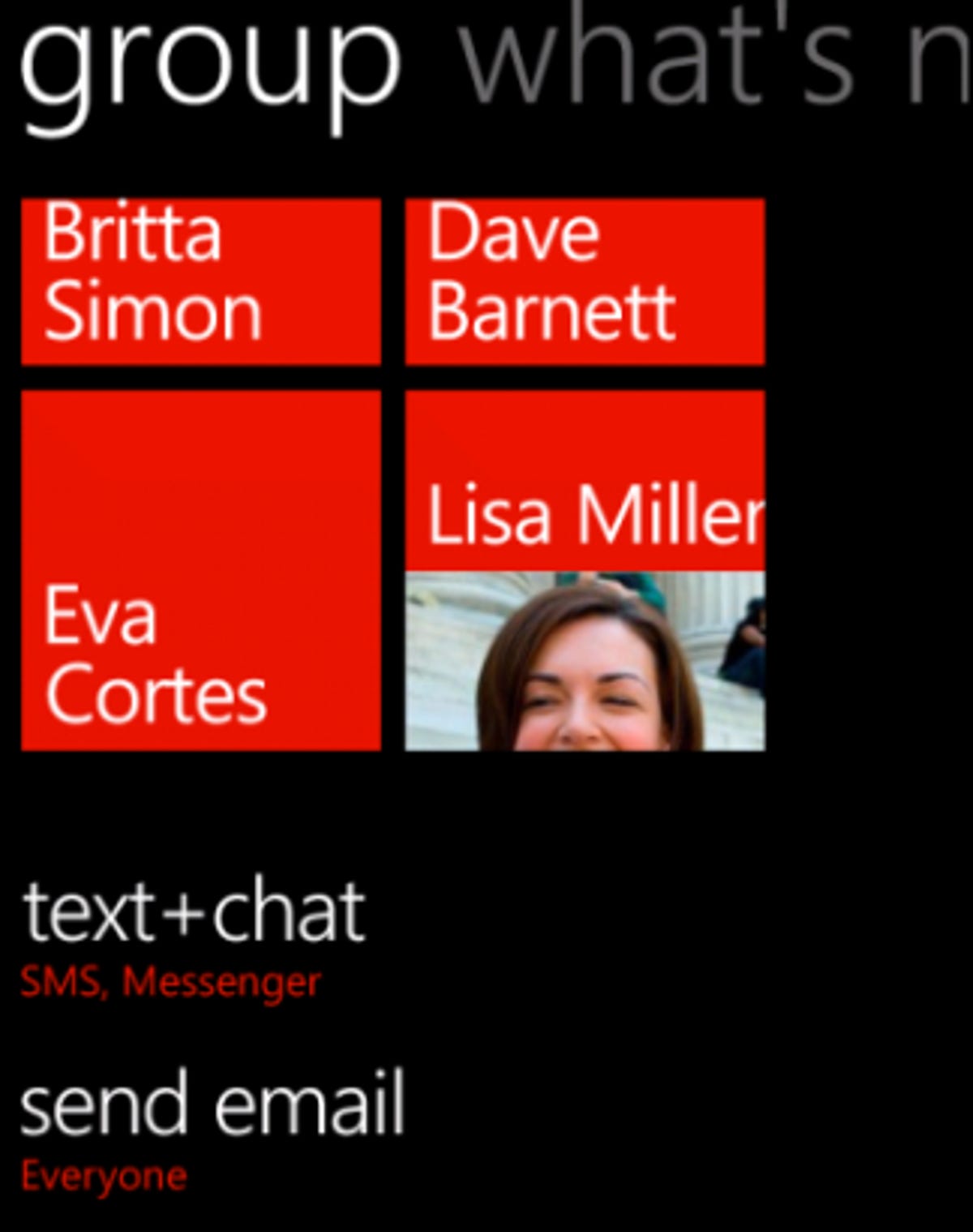
Microsoft
As a nascent platform, the original Windows Phone covered basic social features but lacked others, like support for group contacts.
That’s one of the first things you’ll notice in Mango, and Microsoft has correctly treated it as an extension of the standard contact. As a result, setup simply requires going into the People hub, tapping the + icon, and following the prompts to create a group. Once saved, you can e-mail or message all the members of the group–so long as you have their details. What’s even nicer is that a group acts as a kind of filter to show you just the status updates and photos of a handful of people, rather than your entire contact roster.
As with individual contacts, you can pin a group to the Start screen as well. Live tiles of people or groups now provide additional information, noting when you’ve missed a call or text. In Mango, tapping your own profile gives you new options to post a social network update, check in, and set the chat status.
On a more systemwide basis, Mango welcomes Twitter and LinkenIn into the People Hub, just as it integrated Facebook feeds and contacts in the first version. In addition to seeing your contacts’ updates, you’ll also be able to interact from this space, like launch a Twitter retweet and mention someone directly from their contact record. Facebook gets broader support as well, including check-ins and merging Facebook events into the phone’s calendar. Unfortunately, the feature is read-only, so if you want to delete an event, best scurry off to Facebook to change it.
Messaging and e-mail
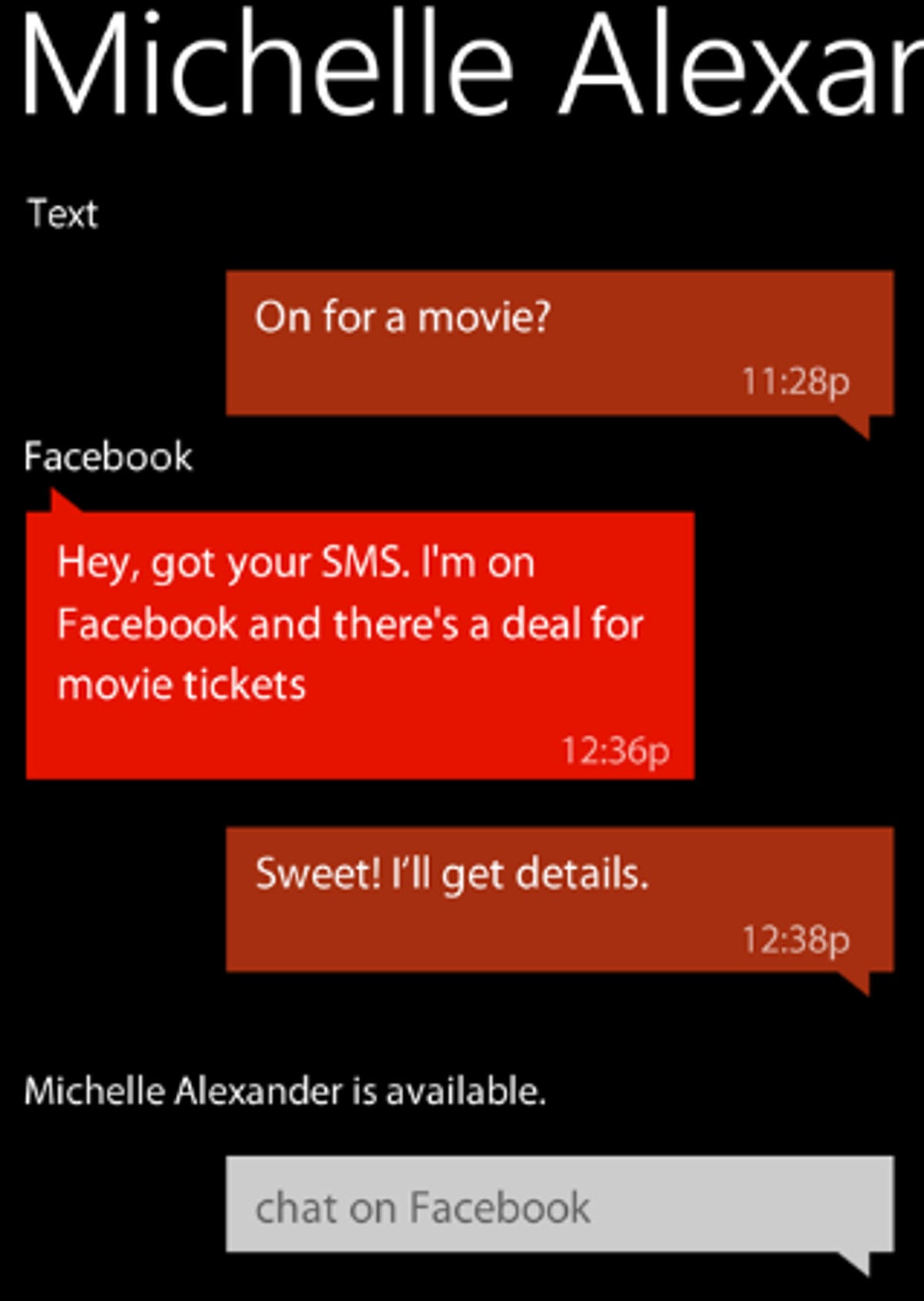

Microsoft
Cleaning up some cluttered interfaces was another piece of low-hanging fruit well within Microsoft’s reach for version 7.5.
Mango threads e-mail messages and text messages, so separate pieces of the same conversation wind up in a single place. All we can say here is this: finally. The same idea of consolidation comes to multiple inboxes, which you can link one at a time to form into a larger inbox by opening the menu (from an open inbox) and selecting the option to link. Even linking two proves too cluttered for our tastes, but we like having choices.
While Microsoft plays catch-up with threaded messages and grouped inboxes, it did take the concept of threads a step further by following a single message thread through text (and photo) messaging and instant messaging. So for instance, if your contact has Facebook chat or Windows Live Messenger turned on, you’ll be able to send a message to them, from the Windows Phone messaging app, through the chat network. If they ignore your message, or if they go offline on the network, you’ll still be able to reach them with a text message–all within the same messaging screen. You can even begin a conversation on Facebook or Windows Live online, and finish it from the phone, and vice versa. It’s neatly and smoothly done, but its utility is limited to the people who use those chat services.
On the corporate side of the coin, expanded support for Microsoft Exchange lets you search for e-mails on the server (hooray!), set up an out-of-office reply, sync your to-do list, and read protected documents and e-mails. We would have preferred seeing all of this in the first release, but better late than never. Unfortunately, Microsoft has not changed its policy on direct Outlook sync, so if you’re not connected through Exchange ActiveSync, you must sync through the cloud (via Windows Live/Hotmail) in order to get your calendar and contacts sorted on the phone. Sigh.
Apps
Since our Mango preview in May, Microsoft’s Marketplace has rocketed from 18,000 apps to 30,000. As tall a jump as that is, it still can’t compete against much larger app stores like Android’s 250,000 titles and Apple’s more than 500,000 apps. While they continue wooing top app makers and independent developers, Microsoft’s plan for integrating apps into other areas of the phone attempts to help you make more of the programs you’ve already got.
For example, the Music + Videos hub now shows you a screen devoted to music-related apps. To see them pop up, two things must happen. First, you’ve got to have the apps downloaded first. Second, the application developer has to enable the feature, called App Connect, on their side. When both conditions are met, you’ll get access to apps–like Slacker Radio or YouTube–as you scroll through this hub.
You’ll also see apps, and suggestions for apps you might want to download, pop up in relation to Bing’s search results, when you search for places, movies, or products–like books. You can also swipe to the new “apps” section to open Amazon or Best Buy, for example, if you’re searching for a product, or Open Table or Yelp if it’s a restaurant you’re after. The feature seems great now, in the final Mango build. However, it will still take time to see if its usefulness plays out, since the whole App Connect conceit requires developers to make their apps available for discovery and only a handful have done that so far. The details will be important, including how many suggestions you’ll see in the Bing results at a given time. In addition, App Connect for Places and Movies will be limited to the U.S. for now, and results for Products will be available for just the U.S., U.K., and France until further notice.
Bing search
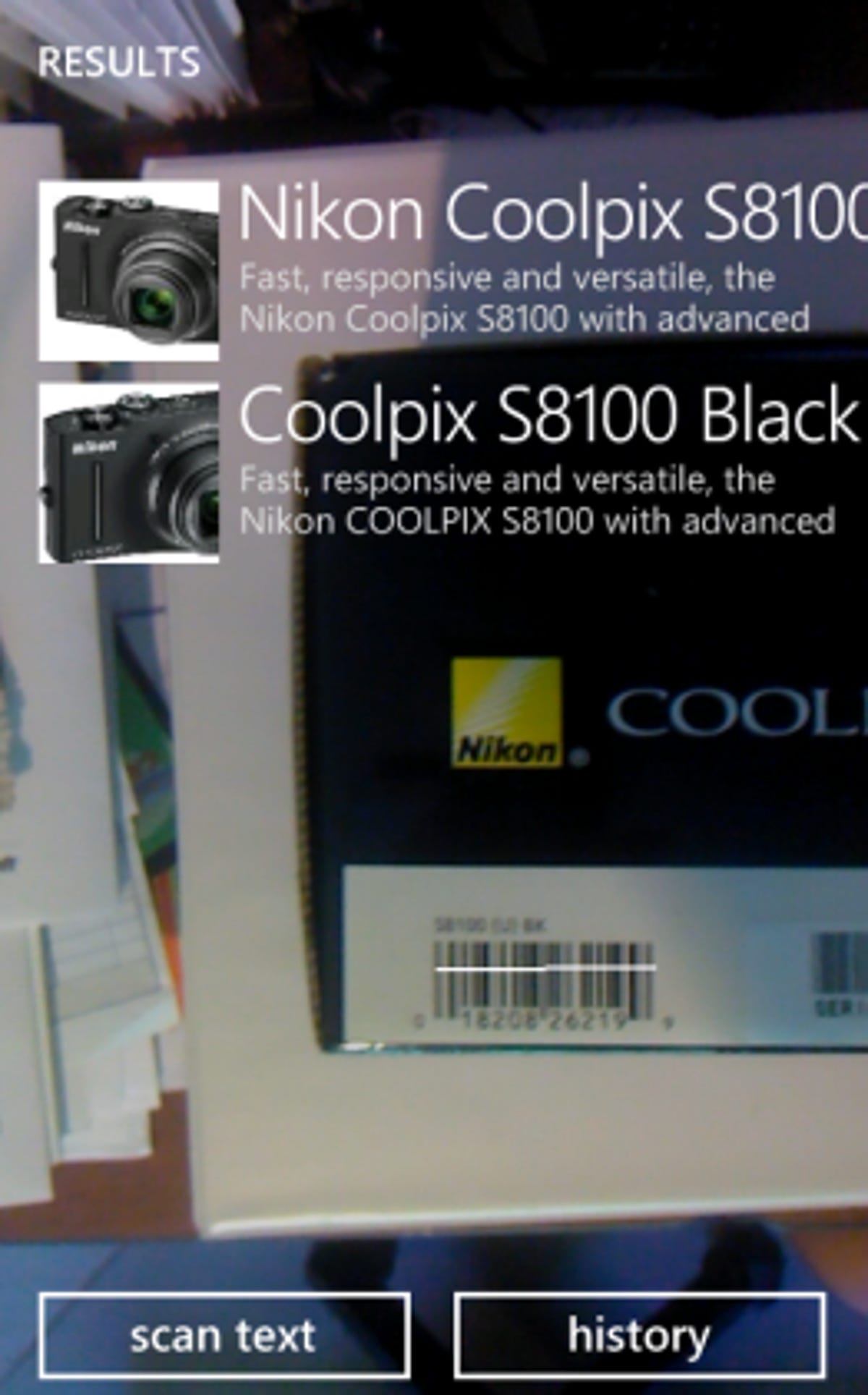

Microsoft
Besides App Connect, Bing is home to some of Mango’s most interesting new features. The Windows Phone 7.5 update gives it new tools: Local Scout, music search, Bing Vision, and voice search (this already existed in Windows Phone 7, but is now brought to the fore).
When you have location awareness turned on in the Bing settings, Local Scout channels Yelp and other restaurant and business databases to serve up dining, events, and retail stores in your immediate area. Tap the sliver of a map up top to expand it and plot your course. The map hooks into reviews, events, and details of the establishment. Scout is a fine idea that seemed to suffer some hiccups during our tests. It was slow to load at times, and although we later discovered filters for ratings and distance, the feature was hidden and unintuitive. We’d also like to see expanded management options that let you fine-tune your location and take you beyond the 20 listed results before marking this feature fully useful.
Bing Vision, on the other hand, is a visual search app that mashes up traditional bar code readers with image-identification software. Press the eye-shaped button and move the phone so the entire bar code, QR code, Microsoft tag, book, DVD, or CD fills the view finder. Without pressing a single other button, Bing Vision will return search results that you can drill into. Barcodes need not be aligned for a successful scan, and the tool remembers past searches. Bing Vision will also (slightly less successfully) scan text that you can opt to translate into a number of languages. Bar code scanning will work for U.S. items only, and text translation won’t work in all regions.
Bing Vision needs some work done for it to live up to its considerable promise–it would be a killer feature tied into certain shopping apps. Search success was hit or miss. The database didn’t match to a new hardback that’s being aggressively promoted in book stores, though it did register the bar code and it did identify some other books, a bottle of hand lotion, and the barcode off a soda can. Although we were told in May that magazines and posters were included in the recognition database, we never had luck getting Bing to recognize Wired, Scientific American, or Bloomberg BusinessWeek. Translation worked well enough, but the software rarely captured the entire text. We’d also like the option of setting a default translation language for longer-term translation requests.
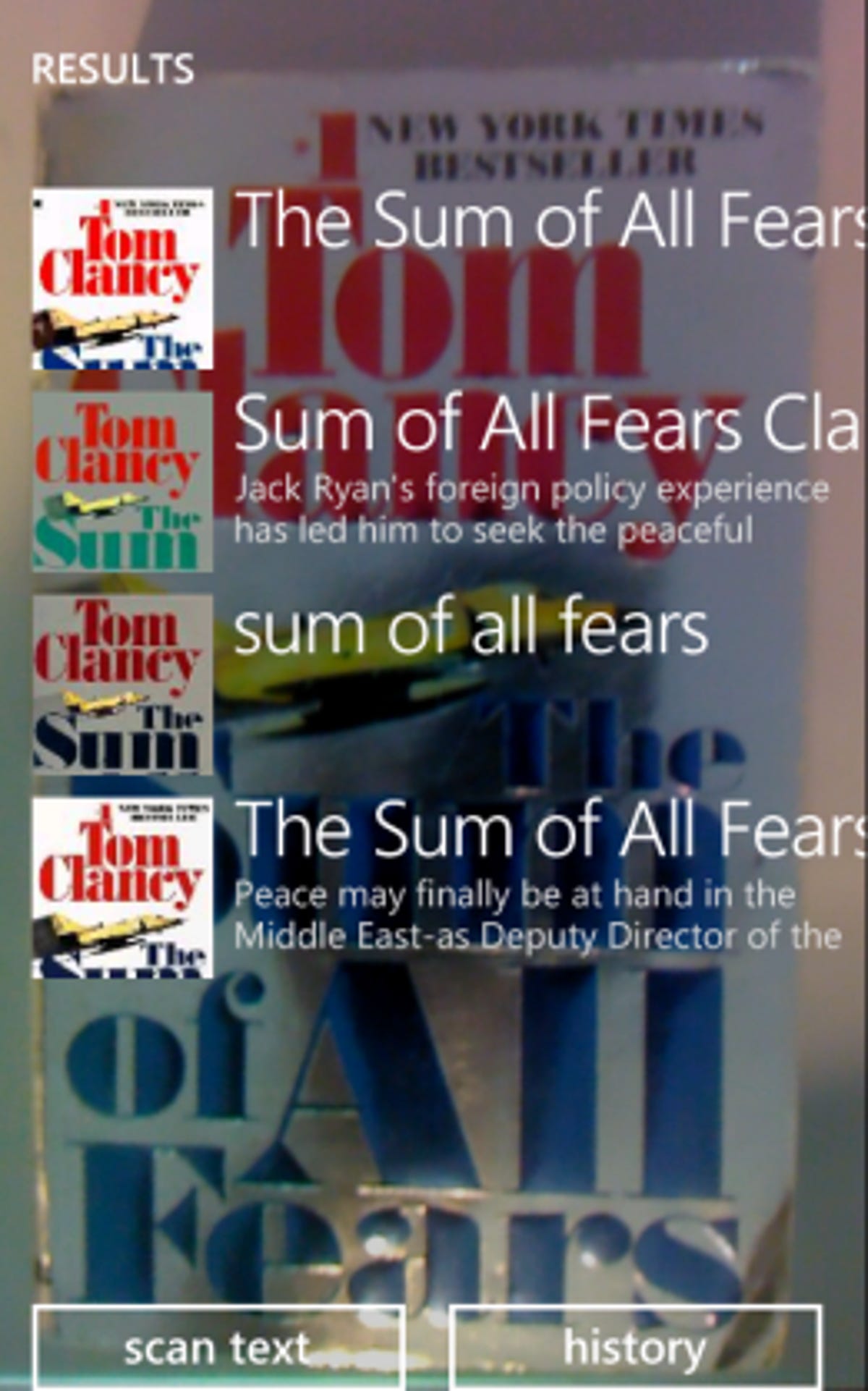

Microsoft
Bing’s final addition, the new music identification feature, is simple and plain, but handy. Like Shazam and other music ID apps, if you launch it while next to a source of recorded music, Bing will attempt to identify the song title and cover art, giving you the option to open the record in the Zune Marketplace app. We experienced some problems in this camp, too. An incoming meeting notification killed the listening feature, and the app didn’t recognize everything we threw its way. At times, it didn’t offer a record for every identified song.
Internet Explorer
The upgrade from a browser based on Internet Explorer 7 to IE9 has been fairly subtle.
Microsoft tinkered with the interface, like moving the address bar to the bottom of the screen and hiding icons to increase the content real estate. GPU-powered hardware acceleration now renders content faster and more efficiently, Microsoft says. Behind the scenes, IE9 jumps on board with the HTML5 Web standard (but not with Flash or Microsoft’s Silverlight). Indeed, the Samsung Focus with Mango loaded graphically rich pages significantly faster than the original Samsung Focus we placed right beside it in simultaneous tests on the same Wi-Fi network.
IE’s ability to share articles and such with social networks like Twitter and Facebook is another welcome feature; before you could share via e-mail or texting. We were able to post messages to Facebook this way; they took just a minute to appear. Protected browsing mode and new “hang” protection were two other features Microsoft has added behind the scenes, but we were unable to test them.
SmartDJ
Microsoft’s Zune integration is one of the Windows Phone’s strongest assets, and it only gets better with Mango. A new feature called Smart DJ works like Pandora and others to create a playlist from your collection based on the artist, song, or album you’re currently playing. Zune Pass subscribers get another boost, since Smart DJ will also include Marketplace songs that when creating a playlist. You can even save playlists and share them with friends via e-mail. We can’t say we always agreed with the artist or song groupings, but we applaud Microsoft for SmartDJ in general.
Voice-to-text


Microsoft; modified by CNET
Voice commands were always part of Windows Phone 7, but Mango lets you compose a text message and instant message with just your voice.
It’s an excellent resource in theory, but in practice, accuracy is only so-so, punctuation and capitalization are absent, and formatting was often bizarre, with spaces between a word and a contraction. The voice-to-text software will work in a pinch for hands-free texting, but it isn’t the most satisfying implementation, mostly because humans trump computers every time. Press and hold the Home button to get started.
Reading out incoming messages is also new. In the Settings, you can choose how and when you want them read–through Bluetooth, wired headsets, or both. Combined with voice dictation, Mango can make your phone a truly hands-free communications device. Many other mobile phones are capable of one or both of these with various apps; we’re also glad to see it here.
Multitasking
This feature’s a misnomer in truth; calling it “task-switching” is more accurate. Like the other mobile platforms, Windows Phone 7 already runs multiple system programs simultaneously. It wasn’t until Mango, however, that you could seamlessly switch among open apps. Just press and hold on the Back (arrow) button beneath the screen and watch the program shrink to a thumbnail size, then swipe left and right to see open programs. Mango will keep your place so you won’t have to reload every time you leave and return to the app. While Windows Phone is late to this party, the welcome feature works well.
Office Hub


Microsoft, border added
There’s quite a bit of added functionality in Mango, including the ability to share and store documents through Office 365 and Windows Live SkyDrive cloud services using the new Locations pane. The Lync Mobile app in Windows Marketplace works with Office 365 to turn on corporate IM and other tools.
Xbox Live
Microsoft has a real growth opportunity when it comes to gaming, especially with the current popularity Xbox enjoys. Gamers will get the boost of having the tools in a separate downloadable app appear in the Xbox hub by default. It lets you customize your 3D avatar, track achievements, and connect with friends. A more visually appealing and descriptive Spotlight section in the Xbox Live hub makes it easier to discover and search for games. Nice, but minor improvements.
Even more goodies
- Visual voice mail–Carrier dependent, official announcements to come
- Wireless mobile hot-spot support–Carrier dependent, official announcements to come
- Front-facing camera–Carrier dependent, official announcements to come
- Hardware Search button always takes you to Bing
- Bing maps get audible read-outs for directions
- Map shows saved favorites; can rotate orientation based on direction
- Indoor maps for malls, airports
- Custom ringtones (sync your own)
- View multiple calendars in one
- Calendar items can build to-do list
- Access camera gallery when phone is locked
- Podcast search and subscription
- Share videos in e-mail or upload to Facebook or Windows Live
- Video player skips ahead or goes back to any point in a clip
- Less robotic automated voice in voice-to-text interaction
- Marketplace links to reinstall apps
Final thoughts: Pros, cons, bottom line
The original Windows Phone 7 software was a gutsy effort that felt decidedly first-generation and unfinished. With version 7.5, Microsoft attempts to build on its metaphor for simple, straightforward features that get you in and out. This time, though, the goal was to make everything smarter and more social, now that Windows Phone must graduate from simply being something new, to something different. In this, Microsoft largely succeeds.
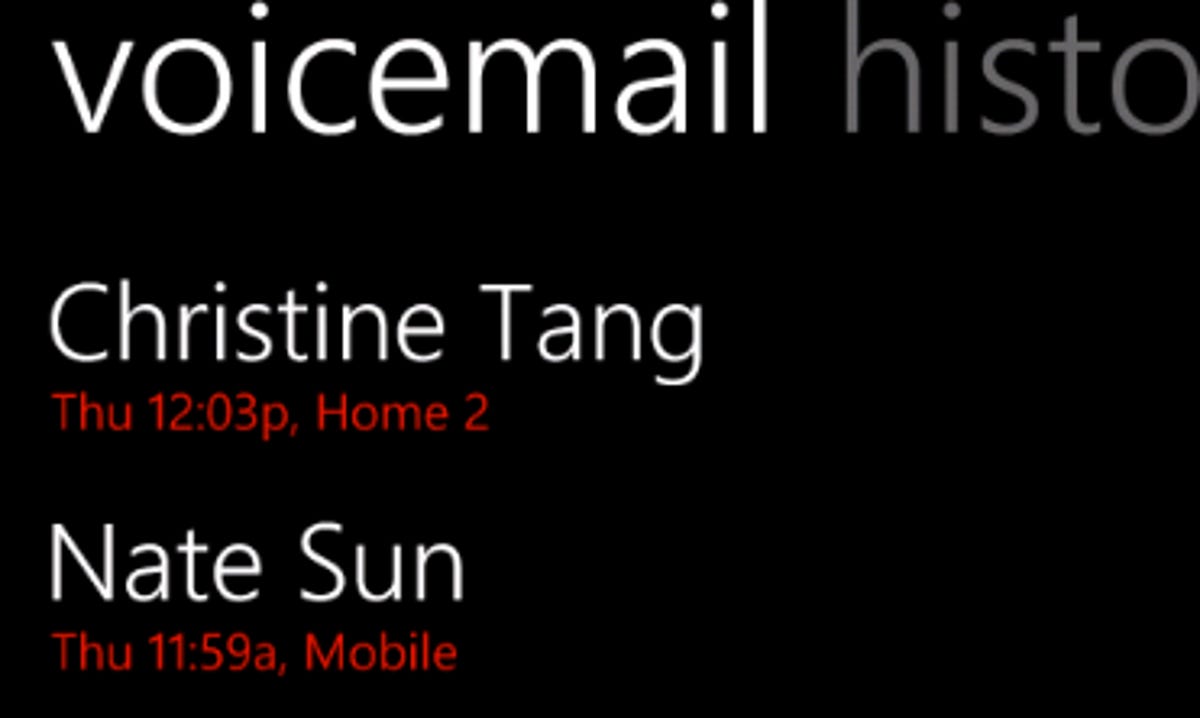

Microsoft
Cons
It’s true that many of the over 500 changes merely bring Mango up to speed with the competition, like the multitasking functionality and hot-spot support, the latter of which many people won’t have a chance to tap into unless they have the compatible hardware to do so and their carriers say they can (phones have not been announced at the time of this review.)
It’s also true that other “enhancements” were lackluster or fell short. Local Scout is a good idea, but the implementation is perhaps a bit shallow. Bing Vision search results are inconsistent, as is voice-to-text (admittedly a really hard feature to perfect.)
We didn’t like how Mango kicks you from the Marketplace to either the app list or the Games Hub when you download an app. Microsoft did this to prove that your app just downloaded, but we were slammed by the downside when we went to install a series of apps on a fresh Mango phone and found ourselves constantly re-entering Marketplace after each app downloaded, just to pick through the menus again and again.
Microsoft has also remapped the search button below the screen to Bing, every time. We would prefer if this were contextual, searching for apps while in Marketplace, music in that hub, and so on, but Microsoft said that users found this behavior confusing, so they’re keeping it consistent.
Then there’s the fact that the start screen and app list still don’t accommodate landscape mode.
Pros
Demerits duly noted, Microsoft has also clearly made an effort to add a little something extra, like the Bing Vision scanning feature, and App Connect. These are great ideas that mostly work out. Microsoft should be applauded for thinking outside the box, and for integrating features intelligently into the OS, rather than letting developers shoulder all the creative work. Then Microsoft should take a gracious little bow and get right back to work doing more.
This brings us back to the heart of the question. Is Mango a good release? As an update that brings scores of new features to Windows Phone, absolutely. The version 7.5 software update makes the OS a more powerful place to be, and enhances the many things there are to like about the platform–the bold, uncluttered visuals of the Metro UI, the dynamic live tiles, the “card” metaphor found in the hubs, the sensible camera app, and the accurate virtual keyboard. As far as we’re concerned, Windows Phone is likable, refreshing, and easy to use.
Windows Phone Mango hands-on (photos)






Is it enough?
But does Mango bring Windows Phone enough? Is it on par with iPhone and Android, today’s mobile titans? Not quite, and there’s no surprise there. Android and iPhone are far more mature and more integrated systems that have the advantage of years’ more development time. Yet when it comes down to it, it’s customers who make or break a platform, and customers don’t care how hard a company tries–just how good the results are.
With Mango, Windows Phone stands a greater chance of survival than it did a year ago when the first Windows phones began poking out of their shells, however the struggle to sell phones will be fierce and relentless, and much will depend on the cool factor of the handsets bearing Microsoft’s name.
We will say this: you should at least consider Windows Phone. Go into a store, get your hands on a phone, and spend some time playing around with the OS. It’ll take some getting used to if you’re already familiar with a different platform, and you may walk away more confirmed in your OS choice than before. But keep an open mind and you just might be pleasantly surprised by Microsoft’s elegant, daring, and simple take on smartphones.



